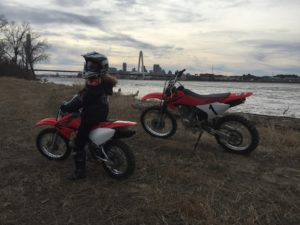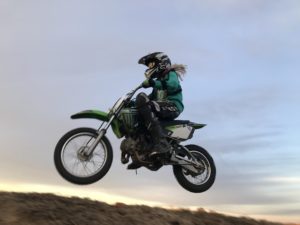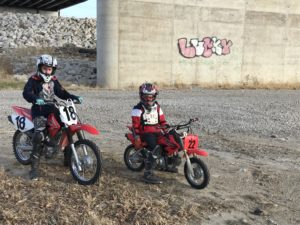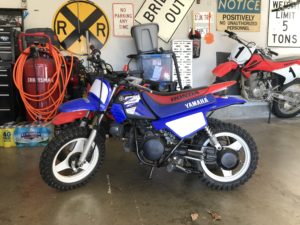
Finding the Right Size Dirt Bike for Your Kid(s)
Here is the deal, you have decided it is time for your kid to get on a dirt bike. Maybe you have ridden since you were a kid, and want to get the whole family riding, so you can go out and have fun together. Or maybe, like me, you made a switch from UTV’s and ATV’s to two wheels for easier storage and transport.
Either way, choosing the correct first bike for your kid can be daunting. There is a wide variety of sizes. The internet forums, while extremely helpful, sometimes give you guidance based on their kid’s skill level and size vs your kid. Even if buying new, sometimes the dealer doesn’t have all of the youth sizes in stock, and different manufacturers have different size offerings.
All 50’s are not created equal! A KTM 50sx is a full 8″ higher seat height than a Suzuki JR50.
As a result, I ended up buying and selling several bikes while learning in the process. The good news is, if buying used, and taking your time to watch the values, you can sell them for as much as you paid for them. The better news is, I compiled a list of all of the seat heights and weights of the various bikes, so that you don’t have to search the entire internet to find them.
To get straight to the sizes, scroll to the bottom.
Alli got her first bike when she was 9, she had some experience on an ATV and a small RZR 170. She was getting pretty brave, so I thought two wheels might slow her down. I also like that we can fit the bikes in our garage.


She was about 4′-6″ so we found a Honda CRF70 that seemed like the perfect size. She promptly ran it into the side of the house and fell. She got up like a champ, and continued to ride it for a while, but she was scared of it, and had a lot of trouble lifting the 128lbs after crashes.
After a couple of months we sold it and got her a Honda CRF50, which was undersized for her. We put some taller pit bike handlebars on it which made her comfortable with the bike, and she proceeded to flog it for two years. The 18lbs lighter and 5″ lower seat height gave her a lot of confidence.

At the same time, Jake wanted a bike because Alli had one, so we got him a Yamaha PW50. He was 5 and 3′-7″. This worked fine for him, but he couldn’t start it himself for about a year. Partially because he is too soft.
For quick reference, Jake didn’t feel comfortable trying the CRF50 until he was 7 and 4′-0″. The PW50 is 25lbs lighter and 2.5″ shorter seat height than the CRF50. The CRF is also semi automatic vs the PW’s no gears.

The one downside to the PW50 is that the rear brake is a hand brake instead of a foot brake. When they switch to a larger bike, it takes a while to get use to the foot brake.
After a couple of years, Alli was ready for a bigger bike, and Jake was ready for the CRF50. I tried to talk Alli into getting a CRF80, but she didn’t want a manual clutch. We ended up getting her a Kawasaki KLX110.
At a 26.8″ seat height, she was already too big for it when we got it (4′-10″), but she was happy with the semi automatic transmission.

After only a few months she conceded that she was ready to try the manual, and would like a taller bike. We looked at Kawasaki KLX110L’s and Honda CRF80/XR80 (I’m not sure what year they changed the letters, but best I can tell, the CRF’s just replaced the XR’s and are essentially the same.)
Despite the engine size, 110 vs 80, the CRF80 is a much bigger bike with 2.1″ taller seat height and bigger wheels, but it is 14lbs lighter than the Kawasaki KLX110.
She ended up with a CRF80, and took to the manual within 10 minutes.
At 4′-1″, Jake could use a bigger bike, but is in a spot where most of the bigger ones are too heavy. He really wants a KTM 50jr.

A few very brief basics:
Two cycle or four cycle (AKA 2 stroke vs 4 stroke)
Without getting into all of the technical details of the two types of engines, with their advantages and disadvantages, I’m going to keep this to the points as it applies to a kids first bike.
Two cycle – you must add oil to the fuel. Either you will have to mix the fuel with the correct amount of 2 cycle oil in a gas can, or (in most cases) the bike will have an oil tank and automatically inject the oil for you. The two cycle will have less low end power. This can be a factor when using the bikes governor, because they’ll have to be able to have enough power to get going, but when it winds up, they may be going way faster than you want them to. The power issue will be more of a factor for kids 4 and younger.
Four cycle – oil and gas are separate, just like your truck or car. You’ll have do do periodic oil changes. 4 cycle bikes are generally heavier than two cycle bikes.
Note – Once you go bigger than 50cc on the 2 cycles, or get a racing version like the KTM 50SX, Cobra 50, they are very fast, and not for beginners – in my opinion. A KX65 for example, is probably a fair bit quicker than my CRF230. I only listed them for reference.
Automatic, semi automatic, and manual transmission
The smallest bikes don’t have gears to shift, just twist the throttle and go. These can be referred to as automatic, because there are no gears to shift, but they really just stay in the same gear all of the time…
The bigger bikes can have one of two types of transmission/clutch styles:
Semi automatic bikes have an automatic clutch, and will have either three or four gears and neutral, all controlled sequentially by a foot shifter. Put your toe under the lever and pull up for 1st, again for 2nd, etc. To down shift you use your foot to push down on the same lever. There is no manual clutch lever to deal with on a semi automatic, just shift the gears. If your child is to small to deal with the gears, you can just reach down, shift it into first or second and let them ride all day in that gear. It will not stall from being in gear.
Manuals will have four or five gears, with neutral usually being a half click between 1st and 2nd gears. They will have a hand clutch lever on the left side of the handlebar, and will require the practice and feel for clutch engagement. If you are reading this article, I will say that you do not want to start your kid out with a manual. Jake is 7, and still uses a semi automatic. We are not a motocross family.
Electric start vs kick start.
The argument goes like this – “Kids are too soft. They should toughen up and learn to kick-start their bike!” How it usually ends up is, you are running over and kick starting their bike because they just are not heavy enough, or are on the side of a hill, etc. When they do get it, it is rewarding to both them and you though. We had all kick-start bikes, because that is what I found. Had I found an electric start bike, I’d have bought it instead. Electric start means that you will have a battery to maintain and replace. I think the only bikes, on the list below, that have electric start are the Yamaha TTR’s and later model Kawasaki KLX’s. You will want to double-check that if it is important to you.

CRF50 21.6″ seat height behind PW50 19.1″ seat height. The 2.5″ and 25lb difference is huge to a 4 or 5-year-old.
Get them out there, and riding!
Please make sure to get all of the proper safety equipment before letting them ride, even around the yard. We make our kids wear helmet, goggles, chest protector, boots and gloves. Recently, they have started wearing knee and elbow pads as well.
Kids bike sizes:
| Make | Model | Seat Height | Weight | Wheelbase | Wheel size F/R | Engine | Transmission |
| Yamaha | PW50 | 19.1″ | 85lbs | 33.7″ | 10/10 | 2 Cycle | Single Speed |
| Suzuki | JR50 | 18.9″ | 84lbs | 33.9″ | 10/10 | 2 Cycle | Single Speed |
| KTM | Mini 50 | 22″ | 88lbs | 36″ | 10/10 | 2 Cycle | Single Speed |
| Honda | CRF50 | 21.6″ | 110lbs | 36″ | 10/10 | 4 Cycle | Semi Auto |
| Suzuki | DRZ70 | 22″ | 121lbs | 36.8″ | 10/10 | 4 Cycle | Semi Auto |
| KTM | 50SX JR | 23.9″ | 83lbs | 35.8″ | 10/10 | 2 Cycle | Single Speed |
| Yamaha | TTR50 | 21.9″ | 119lbs | 36.4″ | 10/10 | 4 Cycle | Semi Auto |
| Yamaha | TTR90 | 24.6″ | 132lbs | 40.9″ | 14/12 | 4 Cycle | Semi Auto |
| Honda | CRF70 | 26.1″ | 128lbs | 42″ | 14/12 | 4 Cycle | Semi Auto |
| Honda | CRF110 | 26.3″ | 163lbs | 41.9″ | 14/12 | 4 Cycle | Semi Auto |
| Kawasaki | KLX110 | 26.8″ | 168lbs | 42.3″ | 14/12 | 4 Cycle | Semi Auto |
| KTM | 50SX | 26.9″ | 92lbs | 40.6″ | 12/10 | 2 Cycle | Single Speed |
| Kawasaki | KLX110L | 28.7″ | 168lbs | 42.3″ | 14/12 | 4 Cycle | Manual |
| Honda | CRF80 | 28.9″ | 154lbs | 47.6″ | 16/14 | 4 Cycle | Manual |
| Kawasaki | KLX140 | 30.7″ | 205lbs | 49.6″ | 17/14 | 4 Cycle | Manual |
| Honda | CRF100 | 30.9″ | 165lbs | 49.2″ | 19/16 | 4 Cycle | Manual |
| Honda | CRF125 | 30.9″ | 194lbs | 48″ | 17/14 | 4 Cycle | Manual |
| Yamaha | TTR125 | 31.7″ | 198lbs | 50″ | 19/16 | 4 Cycle | Manual |
| KTM | 65SX | 30″ | 117lbs | 44.8″ | 14/12 | 2 Cycle | Manual |
| Kawasaki | KX65 | 30″ | 132lbs | 44.1″ | 14/12 | 2 Cycle | Manual |
